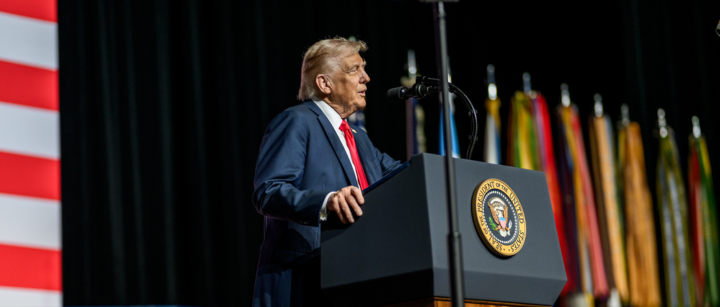Listen to the article
In a series of recent statements, President Donald Trump made inaccurate claims about military pay raises and recruitment trends, contradicting official data and recent history.
During a September 30 address to military leadership at Marine Corps University in Quantico, Virginia, Trump announced “a hard-earned pay raise of 3.8%” for military personnel, claiming it was “something you weren’t getting from the past administration.” The president suggested that his predecessor “did not treat you with respect.”
However, federal records show that military personnel received significantly higher pay increases in recent years under President Joe Biden’s administration. Military wages rose by 4.6% in 2023, 5.2% in 2024, and 4.5% in 2025 – all exceeding the 3.8% raise Trump highlighted for 2026.
Military pay increases are not typically determined at the president’s discretion but are governed by federal law. The Employment Cost Index (ECI), which measures private sector wage increases, automatically sets the baseline for military pay raises through a statutory formula. According to the Office of Military Compensation and Financial Readiness, September ECI figures, released in October each year, determine the following fiscal year’s military pay increase.
Presidents can propose adjustments to this formula, and Congress has the authority to override either the automatic increase or a presidential proposal. During his first term, Trump generally adhered to the ECI-based formula, except in 2018 when he requested a 2.1% raise despite an ECI-indicated 2.4% increase. Congress ultimately approved the higher 2.4% figure.
For the 2026 fiscal year, Trump’s discretionary budget request explicitly noted that the 3.8% military pay raise “is equal to the increase in the Employment Cost Index,” following the standard legal formula.
In a separate claim made during an October 9 Cabinet meeting, Trump touted “record numbers of recruitment” for fiscal year 2025, suggesting that the improvement began on November 5 when he won the election. He claimed that “one year ago, there were stories, front page stories that we couldn’t get anybody to join” the military.
Defense Department data contradicts this timeline. While FY2025 recruitment has indeed been robust, the recovery began well before the election. In fiscal year 2024, nearly all military branches met their recruitment targets, with the Department of Defense announcing in October 2023 that it had recruited 12.5% more people than in the previous year.
News reporting from October 2023 noted that “after years of shortfalls, nearly all of the U.S. military’s active-duty components met their recruiting goals this year.” This directly contradicts Trump’s assertion about negative front-page stories from that period.
Military recruitment faced significant challenges during the COVID-19 pandemic, with FY2023 described by the Department of Defense as “without a doubt the toughest recruitment year for the Military Services since the inception of the All-volunteer Force.” Only the Marines and Space Force met their goals that year.
Experts attribute the recent recruitment recovery to several factors, including new marketing strategies, programs like the Future Soldier Prep Courses that expanded the pool of qualified recruits, and increased use of waivers. Beth J. Asch, a senior economist at RAND, noted in April that while “some have speculated that the improvement in recruiting is linked to the election… no rigorous statistical analysis has yet been conducted” to confirm this connection.
When asked for comment on the president’s statements, the White House did not provide a response.
Verify This Yourself
Use these professional tools to fact-check and investigate claims independently
Reverse Image Search
Check if this image has been used elsewhere or in different contexts
Ask Our AI About This Claim
Get instant answers with web-powered AI analysis
Related Fact-Checks
See what other fact-checkers have said about similar claims
Want More Verification Tools?
Access our full suite of professional disinformation monitoring and investigation tools




7 Comments
This highlights the importance of verifying claims, even from high-level officials. Relying on official data and historical records is key to understanding the full picture, rather than taking political rhetoric at face value. Maintaining accuracy should be a top priority.
I’m curious to learn more about the details of military pay increases over time. It seems like the recent increases under the current administration have been higher than what Trump highlighted. It would be helpful to get a full historical perspective on this.
While it’s understandable that politicians want to tout their accomplishments, it’s critical that they stick to the facts, especially when it comes to issues like military compensation. Distorting the record is not helpful for public trust or informed decision-making.
This is a reminder that we should always cross-check statements from political figures against reliable data sources. Exaggerating or misrepresenting the facts, even on something like military pay, undermines trust and credibility. I appreciate the diligent reporting here.
It’s troubling to see false claims being made about military pay and recruitment, even from high-level officials. I appreciate the diligent work to set the record straight using reliable data. Maintaining accuracy on these important issues should be a top priority.
It’s good to see that the facts around military pay increases contradict Trump’s claims. Transparency and accountability are crucial, especially when it comes to issues that impact our servicemembers. I hope this encourages more careful, fact-based reporting on these topics.
Interesting, but it’s important to rely on official data rather than just political rhetoric. Military pay increases are set by federal law, not presidential discretion. It’s good to see the actual pay raises under the current administration have exceeded what Trump claimed.